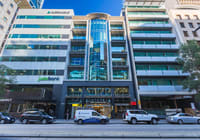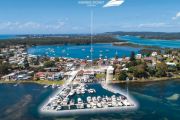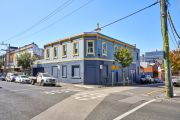
The Broken Hill pub where you can play two-up all year is on the market
There’s good news for those two-up players who made a profit on Anzac Day – ostensibly the only day the game is permitted to be played in pubs – and want to hold on to that winning feeling.
It turns out there’s actually a watering hole where you can play all year round, and it’s for sale for $3,875,000.
The Palace Hotel in Broken Hill is probably best known for its starring role the 1994 film Priscilla Queen of the Desert. But it is also the only pub in the country currently licensed to play the traditional Australian gambling game.
Two-up involves the throwing of two coins into the air. Players bet on whether the coins will fall with both heads up, both tails up, or with one coin a head and one a tail. It is traditionally played in pubs and clubs throughout Australia on Anzac Day, by way of legislation which allows the otherwise illegal activity to be played that day.
In NSW it can also be played after 12pm on Remembrance Day and on August 15 – Victory in the Pacific Day.
The only other location two-up is allowed to be played all year round is in Kalgoorlie, Western Australia – where it is played in a dedicated two-up ring.
 The hotel features over 500 square metres of murals. Photo: Supplied
The hotel features over 500 square metres of murals. Photo: Supplied
The year-round licence to play two-up was granted to the City of Broken Hill by the NSW government in 1992, recognising that the game formed a part of “the living heritage” of the historically significant city, itself the first city in the country to be included on the National Heritage List.
Under the licence, the council can determine which venue has the right to play two-up all year, with the approval of the relevant state minister. It previously rested with the Musicians Club, which relinquished their right to operate the license in 2011, according to local newspaper The Barrier Daily Truth.
A permanent licence was granted to The Palace Hotel by Broken Hill City Council in 2015 and the game is now played there, by the traditional rules, every Friday from 9pm and on days such as Anzac Day, St Patrick’s and Silver City Race days, as well as on demand from larger tour groups.
Part-owner and managing director Selena La Rovere-Nagas said that the time had come for her and the the other owners to reluctantly “move on” after nine years of ownership.
“We’ve put significant investment into it in the nine years, basically over the entire time we’ve reinvested,” Ms La Rovere-Nagas said.
The pub has six owners: Selina La Rovere-Nagas and Fisk Nagas, Todd and Kellie Spain, Katie and Dave Shoobridge, and Esther La Rovere.
There was potential to broaden the Palace’s two-up package, including an exhibition on history, establishing a two-up school, imposing admission charges, and making souvenir sales, she said.
 The murals were designed to make the hotel feel like a desert oasis. Photo: Supplied
The murals were designed to make the hotel feel like a desert oasis. Photo: Supplied
Ms La Rovere-Nagas and Mr Nagas recently purchased the old Broken Hill power station, part of which was converted into a film studio, from Broke Hill Council.
The pub, designed by Melbourne architect Alfred Dunn and recognised as one of his unique and important works, was built as a Coffee Palace in 1889, only six years after the founding of Broken Hill.
It was turned into The Palace Hotel in 1892 and then purchased by a group of mine managers in 1919, who donated it back to the RSL at £1 a year for repatriation of soldiers returning from the war.
In 1946 it was bought by the SA Brewing Company, then Mario Celetto in 1974. Mr Celetto’s son sold the hotel to the current owners in 2009.
 The Priscilla Suite, as featured in the 1994 film Priscilla Queen of the Desert. Photo: Supplied
The Priscilla Suite, as featured in the 1994 film Priscilla Queen of the Desert. Photo: Supplied
Along with 500 square metres of murals created by Mario Celetto and indigenous artist Gordon Way, and a specially themed ‘Priscilla Suite’ – one of 48 accommodation rooms – the hotel once housed a tunnel which is rumoured to have allowed miners after hours access to the hotel.
“The building is certainly a one off. You will not find another one of these in the world. It’s very unique, just the potential of the site is enormous. It’s got such an appeal to so many different markets,” Ms La Rovere-Nagas said.
“People literally seek it out, they knock on your door day-in day-out without any advertising. Some make a special trip to see it.”
As well as the main pub building, the sale includes sheds and land used for garaging, storage and parking, and a double-fronted retail building, which could be turned into a purpose-built facility to house the Priscilla Bus, an outdoor beer garden and dedicated two up gaming area.
“We’ve got the site next door and we’ve got some really good plans that the new owner could put into the mix pretty soon,” Ms La Rovere-Nagas said, adding that there was potential to expand the Palace offering to cater for an international market.
In particular, the Ms La Rovere-Nagas believes that the Priscilla Bus and Priscilla Suite (both featured in the film) have potential to be further capitalised on.
“It doesn’t just cater for regional tourism, there’s the capability to tap into international assets too,” she said.
In 1995 the writer and director of “Priscilla”, Stephan Elliott, donated the ”Priscilla bus”, the giant stiletto and other props from the film to the city.
“The bus has found its spiritual home. More than half of the movie was shot in and around Broken Hill and of course the Palace Hotel was a key feature of the film”, Mr Elliott said at the time.
The Broken Hill City Council has leased out these items to the Palace Hotel.
- The Palace Hotel is being offered for private sale.










